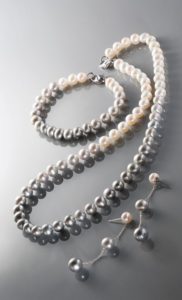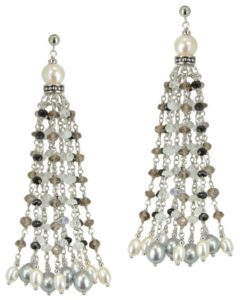Attracting Self-Purchase Women
Jewelers who want to remain successful for the next 25 years should focus more on the self-purchase woman, advocates Marty Hurwitz, CEO of MVI Marketing. The Los Angeles-based consumer market research firm, specializing in the fine jewelry, hails self-purchasing women one of the big three jewelry consumer demographics to pursue, along with millennial bridal and Hispanic/multi-cultural.
 Jewelry marketing is still geared to men buying for women and not women buying their own jewelry, laments Hurwitz, with inventories white diamond heavy when women want color. “Research shows that women avoid traditional jewelry stores to shop for jewelry and are much more comfortable shopping in department stores or boutiques where they sell product as a fashion experience.” He advocates jewelers move from being gemologists to fashion experts.
Jewelry marketing is still geared to men buying for women and not women buying their own jewelry, laments Hurwitz, with inventories white diamond heavy when women want color. “Research shows that women avoid traditional jewelry stores to shop for jewelry and are much more comfortable shopping in department stores or boutiques where they sell product as a fashion experience.” He advocates jewelers move from being gemologists to fashion experts.
Women shop for every type of accessory up to six times a year, except fine jewelry, says Hurwitz. Consumer reports cites women on average buy four pairs of shoes a year. “There’s a big crisis in jewelry inventory that’s stale and doesn’t sell throughout the pipeline. It’s really difficult to survive on one turn a year.”
Hurwitz bemoans that the diamond engagement ring is “the sale of the industry”. “We’re obsessed with it, even though it yields low margins and has enormous competition to sell 2 million engagement rings a year. The industry has to move away from the engagement ring sale as the end-all-be-all.”
Female Factor
Women are the world’s most powerful consumers, and their impact on the economy is growing annually. The global incomes of women are predicted to reach $18 trillion by 2018, according to the global professional services firm EY.
Women own about 40% of America’s privately owned businesses and hold half its wealth—estimated to be $11 trillion of a total $22 trillion by 2020, cites Stephanie Holland, author and founder of She-conomy Birmingham, Alabama. Moreover, earnings of full-time female workers have risen by 31% since 1979, compared to a 2% rise in male earnings. Even with the pay gap factored in, economists predict that by 2024, the average woman in the U.S. will out-earn the average man.
 Women drive 70% to 80% of all consumer purchases, through a combination of their buying power and influence, cites Holland. Roughly 75% of women identify themselves as the primary shoppers for their households.
Women drive 70% to 80% of all consumer purchases, through a combination of their buying power and influence, cites Holland. Roughly 75% of women identify themselves as the primary shoppers for their households.
Sadly, nearly half of women say marketers don’t understand them, cites Holland, who is not surprised considering 3% of ad agency creative directors are women.
If you look at marketing in the jewelry industry it’s very much geared to the male gifter, says Holland. But whether you’re appealing to women buying for themselves or men gifting, the marketing should be directed to women, as they instigate most consumer purchases.
 Fashion Forward, Value Driven
Fashion Forward, Value Driven
Holland advises against “pink” as a strategy to market to women, citing companies like Apple who successfully appeal to women by promoting elements important to them like design, elegance, detail, without screaming this is for a woman. If marketed appropriately, she says it will appeal to men, too.
Women, who make 85% of brand purchases, are loyal to brands, but not for their name, rather what they stand for, says Holland. Transparency is important, and customer service is a key differentiator. She says women do a lot of research to find the products and companies that speak to their values. She advocates marketers look at women by life stages, not age ranges.
Maureen McIntyre the vice president of merchandise for color gemstones and pearls, Richline, New York describes the female self purchaser as smart and value driven. “We feel that the customer buying for herself is looking for something new. She wants to stand out with her purchase, and she knows good value. By incorporating updated styling with interesting gemstones and gold at an affordable price, our latest collections offer a win-win.”
Hurwitz cites the retail sweet spot for self-purchase women is between $99 and $399. He advises jewelers carry more gemstone designs to develop this market, noting that not many women spend $5,000 on diamond jewelry for themselves.
Jewelers need to communicate how their products fit into a woman’s lifestyle, advises Tracy Chapman, women’s marketing expert and director of strategic planning for the New York-based The Terri & Sandy Solution. “Jewelers also need to identify how fine jewelry reflects a woman’s style and works in her wardrobe. They have to make jewelry more of an imperative than a treat, an everyday essential. You need shoes, a belt, a bag—how does jewelry complete the look?”
Chapman describes jewelry as a social currency. “It has symbolism, moments of pride, opportunity for dialogue (i.e. that’s a great necklace) women relate to that. Jewelry makes that fun!”
Designer Sara Blaine, a Benchmark partner based in Atlanta, says women want to be empowered with knowledge and confidence to explore how they can accessorize and create their own signature style with jewelry. “They want jewelry that’s easy to wear, mixes well with other things, and offers good quality and value. That’s how women think about fashion and accessories.”
Honora, a Richline brand, has done a great job of embracing what women want, creating a dialogue for its brand as reinventing the way women look at, wear and buy pearls. With contemporary designs, colors and metals that follow fashion trends, integrating gemstones, Wendy Fox for Honora says the brand has taken pearls from stodgy and conservative to young, hip, ageless, and attainable.
Holland notes that if women are a big part of your customer base, they should be well represented in your business. Research shows that companies with gender-balanced teams have a higher return on investment.







